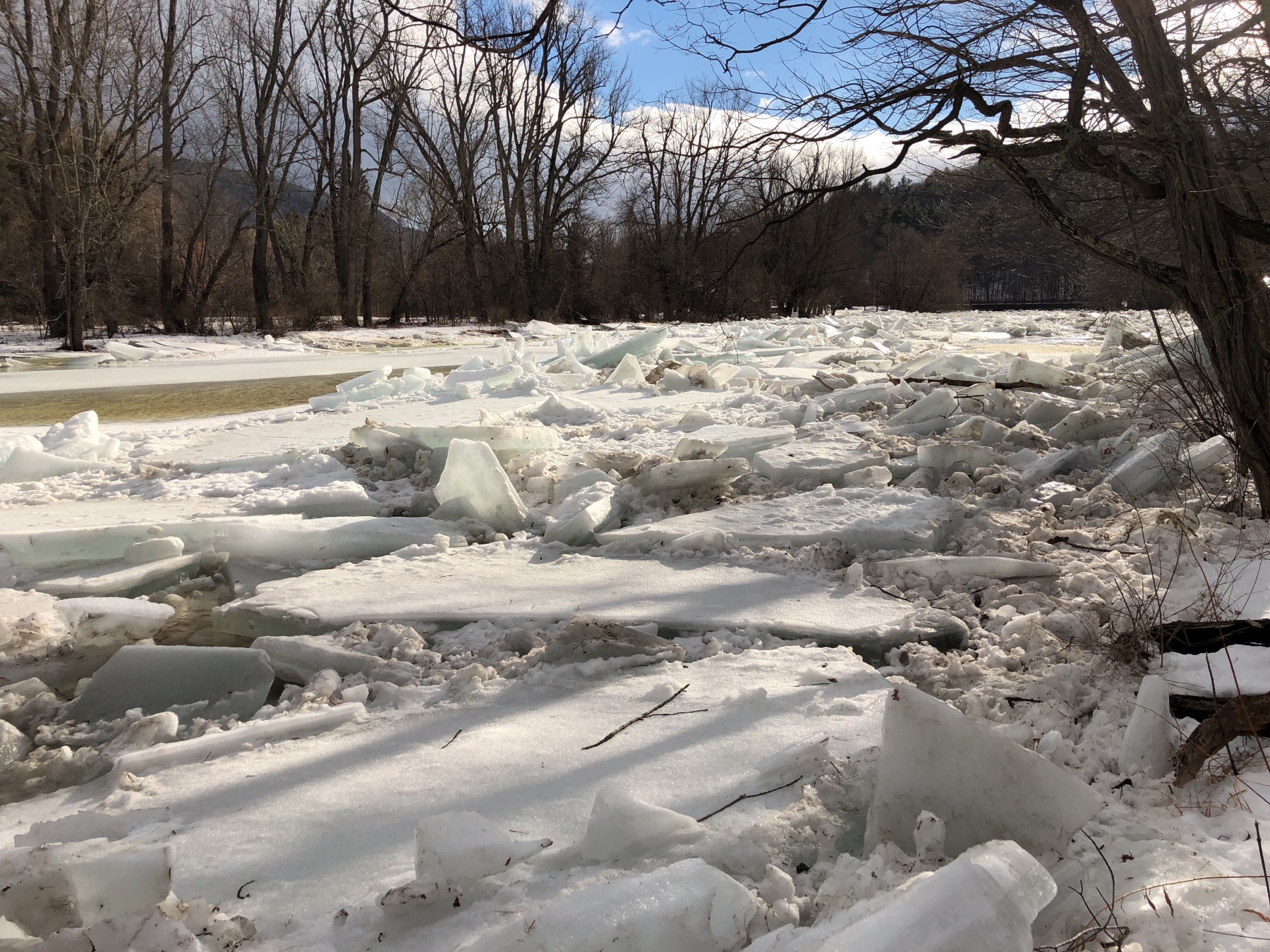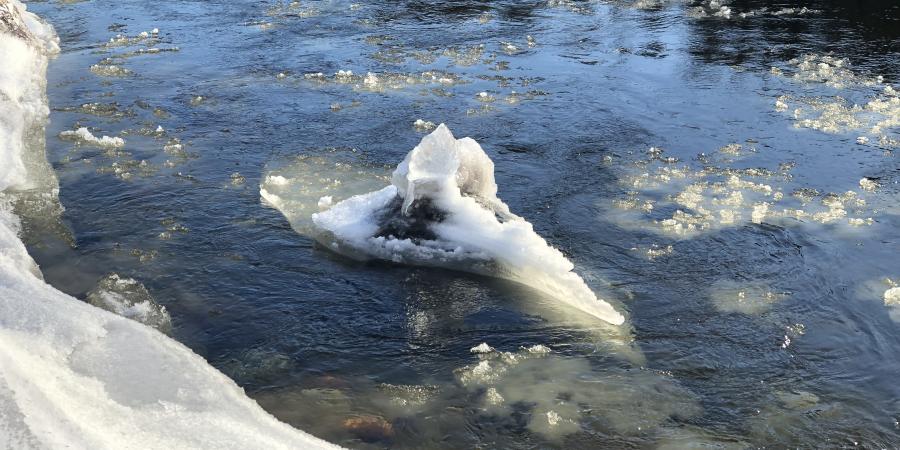Ice jams form when the amount of ice moving in the river exceeds the river channel's transport capacity – its ability to move materials downstream. The process begins when cold winters create thick bank to bank ice on streams. Bank spanning surface ice is augmented by frazil ice and anchor ice and can last days, weeks, or months, expanding and dissipating with changing weather.
This ice breaks up and eventual ice-out occurs naturally via two related processes: warming temperatures and solar heat that melts stream ice, and/or rain events and snow melt that raise water levels – in turn stressing and breaking up channel ice. Spring weather invariably leads to ice-out, but mid-winter thaws and rain events can also break up ice. In some years, extended periods of warming temperatures in winter or spring, allow even thick stream ice to melt and break up gradually and move out of a stream system with minimal threat to public infrastructure. In other years, ice-out is less organized with plates of broken ice creating jams that can scour streambeds, deposit on floodplains and streamside roads, and cause flooding.
Picture an ice-covered river with a thick plate of bank to bank surface ice. The river continues to flow underneath. In a January thaw, moderate rainfall and melting snow produce significant runoff over land and in tributaries. Water levels rise in the river and begin to push against and stress the thawing surface ice. When water levels rise 1.5 to 3 times the thickness of the ice, they can lift surface ice and break it into pieces that begin to move downstream. As they move downstream, depending on water levels, surface ice, debris, and water may move out of the channel and onto adjacent low-lying areas, reducing the amount of ice the river must transport. Where the moving ice meets significant constrictions in the river – the abutments of narrow bridge, a river bend, an over-wide shallow low-slope area, an impoundment upstream of a dam, or another area with channel-bridging surface ice – it can slow or stop the ice. When the amount of ice has exceeded the transport capacity of the river channel, it will stop moving downstream. Instead, the jagged sections of ice back up and accumulate, creating a jam. Water continues to flow under and over the jam sometimes spilling out on adjacent low elevation land. Ice jams can become ice dams, ice filling the channel side to side and top to bottom, temporarily damming water flow and causing upstream water levels to rise. In this extreme case, upstream flooding – the displacement of water flows, ice and debris out of the channel, can be severe.
A jam will remain in place until it is released by warming sun and temperatures or stress from increased water levels in the channel. The cycle of releasing and jamming can reoccur until the ice thaws or breaks up enough to move through the river system within its capacity. Ice jams can release gradually with little to no impact, or suddenly, creating a surge of water and ice downstream that can flood land adjacent to the river and scour the river’s channel, bed, and banks.
Can We Stop Ice Jams?
We cannot stop jams from ever occurring, but we can reduce their frequency and impact by reducing the number of human-made constrictions that cause them and improving the form and function of the river. A river that can access its floodplains and efficiently move and manage its sediment – without eroding banks or creating bars or islands of excess cobble – will better manage ice flows.
Where human communities – homes, businesses, roads – are located near banks or in the floodplain, ice jams can be significant threats to this infrastructure and to public safety. Here, reducing the impact of ice-jams is essential. Removing vulnerable development from floodplains to save lives and reduce recurring costs of emergency services is one option but may not be economically feasible for the residents involved or their communities. Short-term, emergency solutions are limited – to protect freshwater resources and stream integrity machinery is not allowed into streams during winter and spring months. Local and state governments have successfully used excavators positioned next to streams on roadways or stable floodplains to help alleviate ice jams by removing ice and opening a pilot channel – as was done on the East Branch Ausable River near the hamlet of Upper Jay in early 2019. Such emergency responses provide short-term relief but are costly for communities.
In the end, we must look for long-term solutions that create flood resilience for our communities and reduce infrastructure damage caused by ice jams. Identifying human-made constrictions that can be upgraded or removed, restoring sections of the river that have lost their natural sediment transport capacity, ensuring that ample undeveloped floodplains are available to allow overflow of water and ice, and understanding ice formation and transport in each specific river system, are important steps that together can make a difference. The Ausable River Association is working with ice and river specialists and community leaders to develop comprehensive restoration plans for the Ausable system that prioritize resilience. Other efforts at the state and local level are underway – identifying methods for protecting our streams while reducing threats to infrastructure by alleviating the impacts of ice formation and jams. It is a long-term but achievable goal that improves public safety, protects our clean water, restores stream health, and conserves habitats – all benefits for our communities, human and wild.

2019 ice jam below the Upper Jay, NY bridge (SR 9N) on the East Branch Ausable River.
Top Photo: Frazil ice floats downstream on the East Branch Ausable River alongside thick surface ice.
Story written by Kelley Tucker, Executive Director.
Sign-up for our e-newsletter to get weekly updates on the latest stories from the Ausable River Association.




